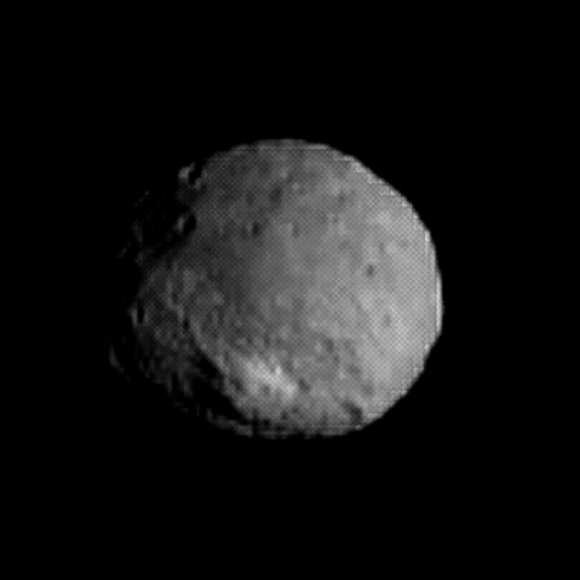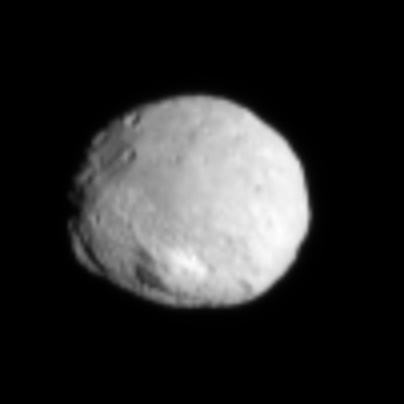[/caption]
The Dawn spacecraft is getting closer to asteroid/protoplanet Vesta, and the view is getting better! Here’s the latest image, which was obtained with Dawn’s framing camera on July 1, 2011 and just released today. It was taken from a distance of about 62,000 miles (100,000 kilometers). Each pixel in the image corresponds to roughly 5.8 miles (9.3 kilometers). Features like craters are starting to sharpen as the spacecraft moves closer, as well as the lumps, bumps and variations in color.
The most exciting part of this mission will be finally figuring out what Vesta really is. Here, it’s looking more like a squished version of our own Moon; a little smoother than I was expecting from some of the earlier images.
Some astronomers classify Vesta as an asteroid, some a protoplanet, and some are on the fence. It’s not really considered a dwarf planet, but the classification could be re-evaluated when Dawn gets in orbit of Vesta and studies it in detail.
Below is an “enhanced” view by Stu Atkinson:

Stu sent us this image with the caveat that he created it for his own amusement/entertainment, and that it’s not a scientifically enhanced image — i.e., it’s not to be 100% relied upon for feature identification, etc. But some of the craters show up a tad better.
Vesta is pretty much an enigma: too big for an asteroid and more evolved than other asteroid. But it is kind of too small for a planet (even a dwarf one). But that’s why it is so interesting so scientists and getting Dawn in orbit will be exciting.
Stay tuned for more!


There’s always something out there that challenges how we classify things, and Vesta is no different. It’s times like these that I think we should come up with a new term to describe the object.
That being said, I can’t wait until Dawn reaches Vesta.
Alright, then proto dwarf planet or megasteroid. 😀
Alright, then proto dwarf planet or megasteroid. 😀
It is present also smooth terrain, as we can observe on comet Tempel?
Is that the crater we were expecting or is this the far side.? Looks like a mound in this image. Perhaps volcanic? How exciting.
That’s an interesting possibility, given that it’s interior was molten at one time due to Iron-60 and Aluminum-26’s decay AND Vesta might have sported a magma ocean at one time or another. Have a look at the section on geology:
http://en.wikipedia.org/wiki/4_Vesta
Follow the citations for some interesting articles.
It seems to me most mounds are impact related? Playing the likelihood game, this isn’t a volcanic feature then.
[But I guess there should be some volcanic features, as A. Houser notes.]
I was not aware that size was a consideration when determining that a body was a dwarf planet. Why is Vesta not considered a dwarf?
According to IAU definition of a planet:
Or coz at teh in-Vesta meet, teh bosses sa’id “eet ees not “dwarf”, eet ees “planetary challenged”” … no, ah dinna buy nuthin’ ov eet too.
If I remember correctly, part of the classification will depend on if they are able to determine if category “b”, as Ivan put it, existed prior to the large impact that warped the shape of Vesta.
Either way, it’s pota-to po-tato
Let’s call it an awkward planet. It is a young teenager who is two big to be called a child and still immature as an adult. They are in that awkward age. Vesta is like that. It does not fit the true difinition of a asteroid but don’t have the size to be called a dwarf planet. Either way I can’t wait until July 16th when Dawn snaps those closeups.